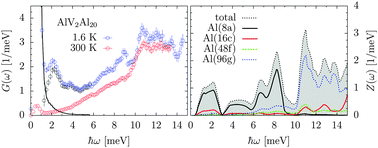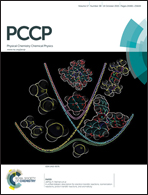On the microscopic dynamics of the ‘Einstein solids’ AlV2Al20 and GaV2Al20, and of YV2Al20: a benchmark system for ‘rattling’ excitations
Abstract
The inelastic response of AV2Al20 (with A = Al, Ga and Y) was probed by high-resolution inelastic neutron scattering experiments and density functional theory (DFT) based lattice dynamics calculations (LDC). Features characteristic of the dynamics of Al, Ga and Y are established experimentally in the low-energy range of the compounds. In the stereotype ‘Einstein-solid’ compound AlV2Al20 we identify a unique spectral density extending up to 10 meV at 1.6 K. Its dominating feature is a peak centred at 2 meV at the base temperature. A very similar spectral distribution is established in GaV2Al20 albeit the strong peak is located at 1 meV at 1.6 K. In YV2Al20 signals characteristic of Y dynamics are located above 8 meV. The spectral distributions are reproduced by the DFT-based LDC and identified as a set of phonons. The response to temperature changes between 1.6 and ∼300 K is studied experimentally and the exceptionally vivid renormalization of the A characteristic modes in AlV2Al20 and GaV2Al20 is quantified by following the energy of the strong peak. At about 300 K it is shifted to higher energies by 300% for A = Al and 450% for A = Ga. The dynamics of A = Y in YV2Al20 show a minor temperature effect. This holds in general for modes located above 10 meV in any of the compounds. They are associated with vibrations of the V2Al20 matrix. Atomic potentials derived through DFT calculations indicate the propensity of A = Al and Ga to a strong positive energy shift upon temperature increase by a high quartic component. The effect of the strong phonon renormalization on thermodynamic observables is computed on grounds of the LDC results. It is shown that through the hybridization of A = Al and Ga with the V2Al20 dynamics the matrix vibrations in the low-energy range follow this renormalization.


 Please wait while we load your content...
Please wait while we load your content...